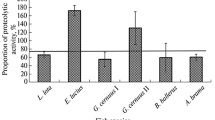Abstract
The proteolytic activities of homogenates prepared from the second larva (L2) and the third larva (L3) as well as the adult stage of the eel-pathogenic nematodeAnguillicola crassus were examined using hemoglobin, azocoll, elastin-orcein, and keratin azure as substrates. Whole bodies of L2 larvae, the anterior third of the bodies of L3 larvae, and the anterior fifth of the bodies of adults were studied. Extracts of L2 contained a trypsin-like proteinase exhibiting a molecular weight of 38000 Da on gelatin-substrate gel electrophoresis. The proteinase showed a pH optimum at 8 and activity against azocoll and keratin. An apparent molecular weight of 25000 Da was determined for the trypsin-like proteinase of the L3. This enzyme possessed collagenolytic, keratinolytic and slight elastinolytic activity at an optimal pH of 8. Samples of adults contained an aspartyl proteinase with a molecular weight of 90000 Da. When hemoglobin was used as the substrate, the enzyme displayed optimal activity at pH 5. It was concluded that the proteinases of the larval stages are penetration enzymes, whereas that of the adult stage is a digestive enzyme.
Similar content being viewed by others
References
Belpaire C, De Charleroy D, Thomas K, Van Damme P, Ollevier F (1989) Effects of eel restocking on the distribution of the nematodeAnguillicola crassus in Flanders, Belgium. J Appl Ichthyol 5:151–154
Boon JH, Cannacrts VMH, Augustijn H, Machiels MAM, De Charleroy D, Ollevier F (1990) The effect of different infection levels with infective larvae ofAnguillicola crassus on haematological parameters of European eel (Anguilla anguilla). Aquaculture 87:243–253
De Charleroy D, Grisez L, Thomas K, Belpaire C, Ollevier F (1990) The life cycle ofAnguillicola crassus. Dis Aquat Org 8:77–84
Hartmann F (1989) Investigations on the effectiveness of levamisol as a medication against the eel parasiteAnguillicola crassus (Nematoda). Dis Aquat Org 7:185–190
Kennedy CR, Fitch DJ (1990) Colonization, larval survival and epidemiology of the nematodeAnguillicola crassus, parasitic in the eel,Anguilla anguilla, in Britain. J Fish Biol 36:117–131
Knox DP, Kennedy MW (1988) Proteinases released by the parasitic larval stages ofAscaris suum and their inhibition by antibody. Mol Biochem Parasitol 28:207–216
Køie M (1991) Swimbladder nematodes (Anguillicola spp.) and gill monogeneans (Pseudodactylogyrus spp.) parasitic on the European eel (Anguilla anguilla) J Cons Int Explor 47:391–398
Kuwahara A, Niimi A, Itagaki H (1974) Studies on a nematode parasitic in the air bladder of the eel: I. Description ofAnguillicola crassa n. sp. (Philometridea, Anguillicolidae). Jpn J Parasitol 23:275–279
Lamah T, Franz M, Mehlhorn H, Taraschewski H (1990) Comparison dePhilometra ovata Zeder, 1803 et d'Anguillicola crassus Kuwahara et al., 1974 (Nematoda, Dracunculoidea): études en microscopie photonique et électronique à transmission. Ann Sci Nat Zool Paris 11:123–133
Lecroisey A, Tong NT, Keil B (1983) Hypodermin B, a trypsin-related enzyme from the insectHypoderma lineatum. Eur J Biochem 134:261–267
McKerrow JH, Brindley P, Brown M, Gam AA, Staunton C, Neva FA (1990)Strongyloides stercoralis: identification of a protease that facilitates penetration of skin by the infective larvae. Exp Parasitol 70:134–143
Molnar K Szekely C, Baska F (1991) Mass mortality of eel in Lake Balaton due toAnguillicola crassus infection. Bull Eur Assoc Fish Pathol 11:211–212
Moravec F, Taraschewski H (1988) Revision of the genusAnguillicola yamaguti, 1935 (Nematoda: Anguillicolidae) of the swim bladder of eels, including descriptions of two new species,A. novaezelandiae sp. n. andA. papernai sp. n. Folia Parasitol 35:125–146
Neumann W (1985) SchwimmblasenparasitAnguillicola bei Aalen. Fischer Teichwirt 11:322
Peters G, Hartmann F (1986)Anguillicola, a parasitic nematode of the swim bladder spreading among eel populations in Europe. Dis Aquat Org 1:229–230
Read SM, Northcote DH (1981) Minimization of variation in the response to different proteins of the Coomassie blue G dyebinding assay for protein. Anal Biochem 116:53–64
Rupova L Dragneva N, Bankov I, Ossikovski E (1984) Investigation on a protease complex from adultAscaris suum: I. Isolation of an acid protease and characteristic of its properties. Helminth 21:257–265
Sakanari JA, McKerrow JH (1990) Identification of the secreted neutral proteases fromAnisakis simplex. J Parasitol 76:625–630
Sprengel G, Lüchtenberg H (1991) Infection by endoparasites reduces maximum swimming speed of European smeltOsmerus eperlanus and European eelAnguilla anguilla. Dis Aquat Org 11:31–35
Szekely C, Lang M, Csaba G (1991) First occurrence ofAnguillicola crassus in Hungary. Bull Eur Assoc Fish Pathol 11:162–163
Taraschewski H, Stemmer B (1992) Host specificity and fine structure of the developmental stages of the eel-pathogenic nematodeAnguillicola crassus. Parasitol Res (in press)
Taraschewski H, Moravec F, Lamah T, Anders K (1987) Distribution and morphology of two helminths recently introduced into European eel populations:Anguillicola crassus (Nematoda, Dracunculoidea) andParatenuisentis ambiguus (Acanthocephala, Tenuisentidae). Dis Aquat Org 3:167–176
Taraschewski H, Renner C, Mehlhorn H (1988) Treatment of fish parasites: 3. Effects of levamisole HCl, metrifonate, fenbendazole, mebendazole and ivermectin onAnguillicola crassus (nematodes) pathogenic in the air bladder of eels. Parasitol Res 74:281–289
Author information
Authors and Affiliations
Rights and permissions
About this article
Cite this article
Polzer, M., Taraschewski, H. Identification and characterization of the proteolytic enzymes in the developmental stages of the eel-pathogenic nematodeAnguillicola crassus . Parasitol Res 79, 24–27 (1993). https://doi.org/10.1007/BF00931213
Accepted:
Issue Date:
DOI: https://doi.org/10.1007/BF00931213



